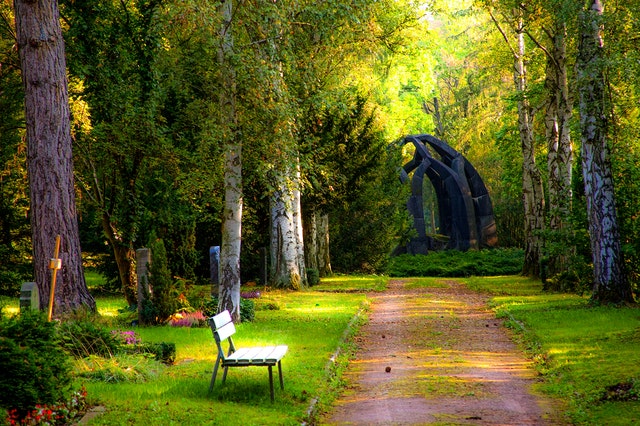Irwin: For the photo-op, exactly. Especially all the stuff around the building. Which is okay in a way, except that you really can’t get a great tree that way, except that you really can’t get a great tree that way. First of all, back at the nursery, to make trees so they’re salable and to rush them long, they do things to them: They top them and what have you to speed along the growth and fill out the tree. This tree, for example, is ideally a single leader tree: the single central trunk going all the way up. That’s its real strength. But anytime one of them is more than two years old now, you just can hardly find any that haven’t already been topped off and become dual or triple leaders, you know? So the tree never obtains its real stature: I mean the beauty of it as it grows naturally.
Weschler: Right.
Irwin: So, in this case, I had to buy small trees and wait ten years. Which is what I’m having to do: ten years before these trees are how I propose them to be. So, at least in terms of how I propose the garden, it will not be finished now for another seven years. Which is a big difference from being a painter or something like that, where you never work on something with that long a time- frame. But for me, first of all, it’s a change of values- the values I get to base my decisions on- and it allows me to do something which is more intimate from the outset. Since it was material that I wasn’t familiar with, had never really worked with before, I was doing a lot of just guessing the first time around. Second time around, now I can look with a different eye. I can look at this combination and say, “Well, I really like that. I don’t like this. This one’s not doing what I thought it would do. What can we do if we change it? “And then do it again next year and then do it again the following year. In other words, now I’ve got this living palette with a mind of its own.
The First year, I decided if I w2as going to err, I was going to err on the side of excess, because I wanted to see what was possible. I wanted to see all the possibilities. And so this past summer, I felt the garden was actually too chaotic .Even for me. And so for next year, I’ve got a better idea why that was so, and what I really liked. What I could eliminate. What I could, in a sense, consolidate. Things that I could maybe feature a bit more, organize a bit better. And I’ll do that. But you can’t do that without having it there to look at, really; you need that firsthand, hands-on-
Weschler: You’re saying it’s going to take ten years for all this to happen? You’re seventy years old. I mean, this is a garden that’s going to-
Irwin: Right.
Weschler: But you’re doing a work that clearly, by definition, is going to have to outlive you.
Irwin: Well, yeah. But in all sorts of critical ways, it’s going to be resolved, if not finished. There are a lot of things about it that are not going to change: They’re not going to change the path or the stream. They’re not going to change those trees once they’re in place. All the structure and all the major elements are going to be there. The one thing that’s very flexible and continuously changing its plant material. But I’m going to give them a pretty elaborate plan that they can follow the spirit of. You Know? That spirit will be clear when I get to the end; the idea of sequencing the areas, the idea of the different kinds of strategies we’re using, like reserving the strongest colors for the end. I mean, when I leave, I will actually give them a very specific document that they can follow. Now, they won’t follow it in every detail; as time goes by, they’ll move away from it to some degrees, I’m sure. To what degree, of course, I don’t know.
Weschler: How does that compare with the occupants of, say, a Meier building-how, after he leaves, the occupants inevitably start changing it?
Irwin: It’s a whole different idea about the ideal or the sublime. Meier’s got this idea of some kind of abstract perfection, some ideal form, some Euclidean nirvana, and in his mind, apparently, everything has to be absolute- and he pushes hard towards that end. With I guess that idea that his contribution will somehow transcend change. The problem with that is that it isn’t real in the sense of actually existing the garden thing- as I was saying the other day, things essentially have to really live in the world. And if you get the thing properly structured- all the really main elements, the scale and all the relationships and the other of things re3ally properly put together- it has the strength to survive being lived in.
Weschler: With all the unpredictability of that.
Irwin: With all the unpredictability. Exactly.
Weschler: And the various ambitions and-
Irwin: And courting all that. Courting unpredictability. Courting surprise. Allowing it to happen. And when it happens, in my mind, it’s better that what you can plan. That’s where the real surprise comes in. There are just things that you… Four plants will grow together in some unpredictable way- I mean, I’ve seen it. I looked and looked and looked and looked. And I liked this and I liked this and I liked that flower. But every now and then I’d see what some- body else would call a mistake, an accident, and they’d say, “Gee, we didn’t really plan that, but these four plants grew together. “And I’d say to myself, “That is more interesting, more beautiful, than anything else that we’ve been talking about. “ The plants really have ended up complementing each other in some truly surprising way. So the idea is that you aim at some overall resonance, you put all that in play, and sometimes things work, and sometimes they don’t. But on the whole, once you’ve got the thing going, it always works. It’s just whether it happens to turn out absolutely brilliant. Because when it’s brilliant, it’s brilliant, you know?





